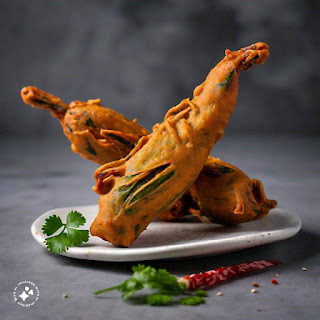Title: The Classic Chicken Pakora Recipe: Crispy, Flavorful, and Irresistible
Introduction:
Chicken pakora, a popular Indian appetizer, is beloved for its crunchy exterior, flavorful spices, and tender chicken inside. This timeless snack has roots in Indian culinary traditions and has gained popularity worldwide for its delicious taste and versatility. In this comprehensive guide, we'll delve into the intricacies of crafting the perfect chicken pakora, exploring its history, ingredients, preparation methods, and serving suggestions.
1. History and Origins of Chicken Pakora:
Chicken pakora has its origins in the Indian subcontinent, where it emerged as a popular street food snack. The word "pakora" is derived from the Sanskrit word "pakvavata," meaning a fried snack. Over time, this dish evolved, with variations emerging in different regions of India and neighboring countries.
Historically, pakoras were primarily vegetarian, made with ingredients like potatoes, onions, and spinach. However, the addition of chicken to pakora recipes became widespread, offering a protein-rich alternative that appealed to meat lovers.
2. Ingredient for classic Chicken Pakora :
- Boneless chicken: Choose boneless, skinless chicken breasts or thighs, cut into bite-sized pieces for easy frying.Boneless
chicken is the perfect canvas for pakora, ensuring uniform cooking and easy consumption. Cut into bite-sized pieces, it absorbs the flavors of the marinade and batter, creating succulent morsels bursting with taste. Versatile and convenient, boneless chicken adapts effortlessly to various spices and seasonings, guaranteeing a delightful pakora experience every time.
- Chickpea flour (besan): This gluten-free flour is the traditional choice for pakora batter, providing a crisp texture when fried.Chickpea flour, or besan, is the cornerstone of chicken pakora, imparting a distinctive nutty flavor and crisp texture. Its gluten-free nature ensures a light and airy batter, while its high protein content adds depth to the dish. A staple ingredient that guarantees a satisfyingly crunchy exterior with each bite.
- Spices: A blend of ground spices such as turmeric, cumin, coriander, garam masala, and chili powder adds depth of flavor and aroma to the chicken pakora.Spices are the heart and soul of pakora, infusing each bite with tantalizing flavors. From cumin and coriander to turmeric and chili powder, they create a symphony of aromatic sensations. Balanced seasoning enhances the depth of the dish, ensuring a harmonious blend of heat, warmth, and spice in every crispy pakora bite.
"//- Garlic and ginger: Freshly minced garlic and ginger paste infuse the chicken with a fragrant kick.Garlic and ginger elevate chicken pakora with their aromatic and flavorful punch. Finely minced or grated, they infuse the marinated chicken with a tantalizing zest. Together, they create a harmonious balance of savory and spicy notes, enhancing the overall taste experience of this beloved dish.
- Baking soda: A small amount of baking soda helps to aerate the batter, resulting in lighter, crispier pakoras.Baking soda is a secret weapon for achieving crispy pakora chicken. When added to the batter, it creates a light and airy texture while aiding in browning. Its alkaline properties also tenderize the chicken, resulting in juicy bites. Just a pinch can make a world of difference in your pakora recipe.
- Oil for frying: Use a neutral oil with a high smoke point, such as vegetable oil or sunflower oil, for deep frying the chicken pakoras.Oil for frying plays a pivotal role in culinary practices worldwide, transforming raw ingredients into delectable dishes through the process of frying. Typically, oils with high smoke points, such as canola, peanut, or sunflower oil, are preferred for frying due to their ability to withstand high temperatures without burning. This characteristic ensures that the food cooks evenly and attains a crispy texture without absorbing excessive oil.
Beyond its functional properties, oil contributes to the flavor profile of fried foods. Different oils impart distinct tastes and aromas, influencing the final taste of the dish. For example, peanut oil adds a nutty flavor, while olive oil infuses a fruity essence.
However, it's essential to consider the health implications of frying with oil. While moderate consumption of fried foods can be enjoyed as part of a balanced diet, excessive intake may lead to health issues due to the high calorie and fat content. Additionally, reused oil can develop harmful compounds through repeated heating, affecting both flavor and health.
In conclusion, oil for frying serves as more than just a medium for cooking; it is a critical element in achieving desired textures and flavors. Understanding the properties of different oils and practicing moderation are key to creating delicious fried dishes while maintaining a healthy lifestyle.
3. Preparation Steps:
a. Marinating the Chicken: In a mixing bowl, combine the bite-sized chicken pieces with minced garlic, ginger paste, salt, and a squeeze of lemon juice. Allow the chicken to marinate for at least 30 minutes to allow the flavors to meld.
b. Preparing the Batter: In a separate bowl, mix chickpea flour (besan) with spices like turmeric, cumin, coriander, garam masala, chili powder, and baking soda. Gradually add water to form a smooth, thick batter. The consistency should be similar to pancake batter, thick enough to coat the chicken pieces evenly.
<
c. Coating the Chicken: Dip each marinated chicken piece into the prepared batter, ensuring it's fully coated. Shake off any excess batter to prevent the pakoras from becoming too thick.Coating chicken pakora is a crucial step in achieving its signature crispy texture and flavorful exterior. First, the marinated chicken pieces are dredged in a mixture of chickpea flour (besan) and spices, ensuring an even coating. Then, they are dipped into a light batter made from chickpea flour, water, and spices, creating a delicate outer layer that crisps up beautifully when fried. This double coating method locks in moisture while providing the perfect crunch. It's a delicate balance between texture and flavor, resulting in irresistibly crispy and delicious chicken pakoras that are sure to tantalize the taste buds..
d. Frying the Pakoras: Heat oil in a deep frying pan or kadhai over medium-high heat. Once the oil reaches the right temperature (around 350°F or 180°C), carefully drop the coated chicken pieces into the hot oil, a few at a time. Fry until golden brown and crispy, turning occasionally to ensure even cooking.Frying chicken pakoras requires precision and care to achieve golden perfection. Heat oil to the right temperature, around 350°F (175°C), ensuring even cooking without burning. Gently lower coated chicken pieces into the hot oil, frying in batches to prevent overcrowding. Fry until they turn golden brown and crispy, about 4-5 minutes per batch. Drain excess oil on paper towels before serving, delivering irresistible pakoras with a satisfying crunch.
e. Draining and Serving: Use a slotted spoon to transfer the fried chicken pakoras onto a plate lined with paper towels to absorb excess oil. Serve hot with your favorite dipping sauce or chutney.After frying, draining pakoras is essential to maintain their crispiness and remove excess oil. Transfer them onto a plate lined with paper towels, allowing them to rest briefly to absorb any residual oil. Serve pakoras hot with your favorite dipping sauce, such as mint chutney or tamarind sauce, for an explosion of flavor. Garnish with fresh cilantro leaves or lemon wedges to add a refreshing touch, enhancing the overall dining experience. Enjoy these delectable treats as a snack or appetizer.
>
4. Tips for Perfect Chicken Pakoras:
- Ensure the chicken pieces are cut into uniform sizes to ensure even cooking.
- Don't overcrowd the frying pan or kadhai, as this can lower the oil temperature and result in soggy pakoras. Fry in batches if necessary.
- Test the oil temperature by dropping a small amount of batter into the hot oil. If it sizzles and rises to the surface immediately, the oil is ready for frying.
- For extra crispiness, you can double coat the chicken pieces by dipping them in the batter twice before frying.
- Serve the chicken pakoras immediately after frying to enjoy them at their crispiest.
5. Variations and Serving Suggestions:
- Vegetable Pakoras: Replace the chicken with sliced vegetables such as onions, potatoes, spinach, or cauliflower for a vegetarian version of pakoras.Vegetable pakoras are a delightful twist on the classic, offering a medley of flavors and textures. Sliced vegetables such as potatoes, onions, spinach, or cauliflower are coated in a spiced chickpea flour batter and fried until crispy. These golden-brown fritters are perfect for snacking or as appetizers. Serve them hot with a tangy dipping sauce like mint yogurt or tamarind chutney for a mouthwatering culinary experience.
- Indo-Chinese Chicken Pakoras: Add a twist to your chicken pakoras by tossing them in a tangy Indo-Chinese sauce made with soy sauce, vinegar, and chili sauce.Indo-Chinese chicken pakoras blend the bold flavors of Indian spices with the zesty tang of Chinese cuisine. Marinated chicken pieces are coated in a batter infused with soy sauce, ginger, garlic, and chili flakes.
"/
Fried until crispy, they offer a tantalizing fusion of savory, spicy, and tangy notes. Enjoy these irresistible pakoras as an appetizer or snack, accompanied by a sweet chili sauce or a side of fried rice for a complete meal.
- Accompaniments: Serve chicken pakoras with mint chutney, tamarind chutney, or a spicy yogurt dip for added flavor.Pakoras pair perfectly with an array of tantalizing accompaniments that enhance their flavors. Tangy tamarind chutney adds a sweet and sour kick, while mint chutney provides a refreshing herbal contrast. Creamy yogurt sauce cools down the spicy heat, and zesty lemon wedges offer a citrusy burst. These accompaniments balance the richness of the pakoras, elevating each bite into a harmonious explosion of taste and texture that delights the palate.
- Pairings: Enjoy chicken pakoras as a standalone snack or serve them as part of a larger Indian meal alongside rice, dal, and
n bread.Pairing pakoras is an art that involves balancing flavors and textures. The crispy exterior of pakoras complements creamy yogurt-based dips, while the savory spices harmonize with tangy chutneys. For a refreshing contrast, serve with a crisp salad or sliced cucumbers. Pairing with a hot cup of masala chai or a refreshing lassi completes the experience, creating a delightful interplay of flavors that tantalize the taste buds.6. Conclusion:
Chicken pakora exemplifies the richness and diversity of Indian cuisine, offering a tantalizing blend of flavors and textures that appeal to food enthusiasts worldwide. Whether enjoyed as a snack, appetizer, or side dish, these crispy delights never fail to impress with their irresistible taste and aroma. By following this classic chicken pakora recipe and experimenting with different variations, you can experience the joy of creating this beloved Indian delicacy in your own kitchen.



.jpg)







0 Comments